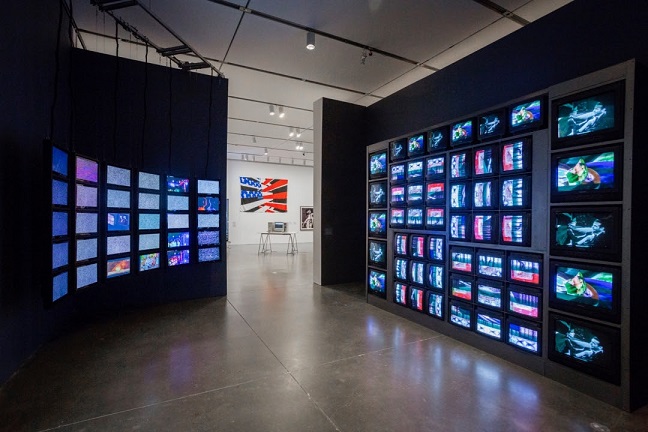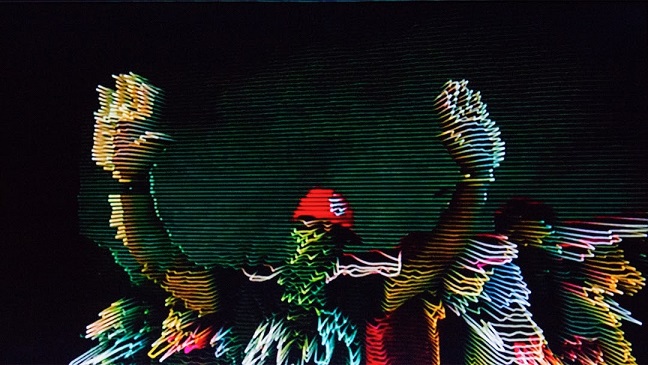A large survey exhibition comprehensively traces the internet’s influence on artistic practice since 1989, uneasily and unexpectedly revealing how it can subsume both the art and its viewing contexts.
Installation view, Art in the Age of the Internet, 1989 to Today, Institute of Contemporary Art/Boston, 2018 (all installation photos by Caitlin Cunningham)
BOSTON — It’s difficult to say precisely what the internet is, or where it begins and ends, even though using it feels so familiar. The Institute of Contemporary Art’s massive, head-spinning survey Art in the Age of the Internet, 1989 to Today grapples with this paradox. It is organized into five thematic sections — Networks and Circulation, Hybrid Bodies, Virtual Worlds, States of Surveillance and Performing the Self. However, the 60 featured artists working in painting, performance, photography, sculpture, video, and web-based projects slip between these categories and reaffirm the internet’s impressive but daunting unwieldiness. Art in the Age of the Internet allows viewers to marvel at how far we’ve come technologically with the internet’s immediate conveniences, but then reveals our embedded, circular reliance on it to ask whether we should — or can — dial it back.
The exhibition is bookended by striking video installations, and Hito Steyerl’s “Liquidity, Inc.” (2014) near one end, is elucidating in its refusal of narrative or formal categorization. At parts, Steyerl’s video personifies water in the subtitles — “even though I cover this planet, I am not from here. And nor are you” — and troubles questions of constructed identities and their resulting segregations. “Liquidity, Inc.” also tells the story of Vietnamese immigrant Jacob M. Wood, a trader and part-time MMA fighter laid off in the wake of Lehman Brothers’ collapse, who returns to the sport as an announcer. He equates keeping your guard up while fighting to maintaining a shock-proof financial portfolio, lest you be surprised by the “kiss of death.” Steyerl cuts from a father fighting in a match, embarrassed to reveal his Starbucks day job, to weather forecasts of collapsed nation states to limp bodies splashing in and cracking the surface of a digitally rendered ocean, to emails about losing the budget for this very piece. The piece creates an ironic, layered critique of class pressures, colonialism, and even art making itself. Water rendered in vector art bubbles and bulges, and speech bubbles stretch and melt across the screen as a voiceover intones, “When you have liquidity, you’re in control.” Steyerl segues between unexpected storylines and builds toward a logic that feels tenuous: a lament of the ever malleable, ever connecting, ever liquid internet’s failure at making real liquidity easier.

Installation view, Art in the Age of the Internet, 1989 to Today, Institute of Contemporary Art/Boston, 2018
The other end of the exhibition puts the viewer between two dense, blistering walls of monitors — Nam June Paik’s “Internet Dream” (1994) and artist collective HOWDOYOUSAYYAMINAFRICAN’S “thewayblackmachine” (2014–ongoing). Paik’s animated, psychedelic loops that imagine the internet as a collaborative, wide-reaching medium rub up starkly against the collective’s culled news reports of police killings of black Americans — each resounding over the other. In 20 years, it seems the internet has succeeded in spreading so much information and so many perspectives they all conflate into white noise. Indeed, “thewayblackmachine” eventually shatters into static. The collective’s video ends with overhead shots of protesters marching against police brutality, uneasily reminding viewers that both their moments of vulnerability and valiance are being recorded, to be interpreted by others.

HOWDOYOUSAYYAMINAFRICAN?, “thewayblackmachine” (still), (2014-ongoing); thirty-monitor video installation, approximately 80 x 30 x 10 inches (203.2 x 76.2 x 25.4 cm) (image courtesy the artists © HOWDOYOUSAYYAMINAFRICAN?)
Work revealing that the flip side of documentation is surveillance has its own section in the exhibition, but the pieces sometimes feel too literal and obvious to be engaging. Trevor Paglen’s “Autonomy Cube” (2014) is a functional Tor router encased in Plexiglas that allows visitors to surf the internet anonymously. But, it’s impossible to know that without reading the wall text, which also prescribes that we should be nervous about using public Wi-Fi and being watched. And the indifferent reactions to Lynn Hershman Leeson’s surveillance doll “CybeRoberta” (1995–1996), impossible to anticipate when the piece was constructed, are both notably ironic and ominously specific to our time: visitors take selfies by photographing its camera. We’re so used to being in front of one that a piece criticizing surveillance inadvertently gives us another chance at self-performance.

Lynn Hershman Leeson, “CybeRoberta” (1995-96); installation with doll, video camera, web camera, internet connection, and custom software; dimensions variable (courtesy the artist and Hess Collection, Bern, Switzerland, photo by Caitlin Cunningham © Lynn Hershman Leeson)
The strongest work in Art in the Age of the Internet is Ed Atkins’s “Safe Conduct” (2016), a three-channel video resembling an airport jumbotron, hanging in its own gallery near the middle of the exhibition. Atkins takes us through airport security with a hyperreal, digital surrogate for himself that has been burned and marred in every possible way. The avatar continually peels layers off his face and appendages off his pustular body, and later removes his liver and brain to send through the X-ray. The grotesque popping and squishing sounds syncopate as additional percussion for the video’s soundtrack of Ravel’s Bolero, and shots of Atkins’ character cut abruptly between sitting, squatting and contorting, as if he’s being cavity searched in prison — or trying to stretch while on an airplane. “Safe Conduct” comically asks what happens when paranoia and precautionary checks are taken so far as to painfully tear one apart. Atkins’ character buckles his seatbelt by securing two bloodied, dismembered arms across his waist, smiling and grimacing as his seat window brightens and pulses — presumably due to the increased radiation from flying at high altitudes — toward implosion. All the while, little triangular logos dance across the screens, reminiscent of the airline safety videos passengers routinely ignore.

Frank Benson, “Juliana” (2014-15) painted bronze with Corian pedestal; sculpture: 23 x 48 x 22 inches (58.4 x 121.9 x 55.9 cm); pedestal: 42 x 53 x 24 inches (106.7 x 134.6 x 61 cm) (Koons Collection, New York. © Frank Benson)
Perhaps the paradox and challenge for Art in the Age of the Internet is that it compartmentalizes artworks about a nebulous subject, that is itself resistant to rules. Oliver Laric’s 3D-printed riff on a Neoclassical sculpture and Pamela Rosenkranz’s sculpture of a body under an emergency blanket are formally and technically interesting, but it seems are only included to neatly reaffirm and transition between categories. The exhibition at times feels like a spatialized essay: works are used like quotes to prove a pre-determined point. But this critique raises a larger question: how else could you organize the internet?
Ryan Trecartin’s and Lizzie Fitch’s “Safety Pass” (2016), a sculptural theater with Trecartin’s video “Permission Streak” (2016), responds that you can’t. A large cast of costumed characters coated in exaggerated, contoured makeup film each other around an old minivan, bitterly and hoarsely shouting saccharine phrases until hearing them leaves a sour taste in your mouth. “I love photo shoots. I just wanna be happy,” one character squeaks. “Was that so, so fun?!” “Shut up Jenny!” The cast collectively melts down to a point of destabilizing violence, but we never see what results. Trecartin sticks us perpetually on set, the cast filming each other repeatedly fighting, bickering and making up. “Permission Streak,” with its rapid-fire whining and shaky filming, shows how the internet invites distraction and the desire to take on multiple identities at once, never settling.

Lizzie Fith/Ryan Trecartin, “Permission Streak” (still), (2016) HD video (color, sound; 21:17 minutes) (courtesy the artist, Regen Projects, Los Angeles, and Sprüth Magers © Lizzie Fitch/Ryan Trecartin)
“Permission Streak” almost embodies Art in the Age of the Internet as a whole, by being so visually overwhelming that by the end it pushes viewers to scarily make generalizations in haste. Cindy Sherman’s “Untitled #463” (2007–08) is about rampant self-performativity; Albert Oehlen’s “Untitled” (2008), with its hand-rendered blurs of digital drawings, must be about the internet’s effacing of human labor. Art in the Age of the Internet makes viewers restless, like when we skim the news – or in this case wall texts – to get just enough to understand, and then forget. This is not to say the exhibition is bad; rather, curators Eva Respini and Jeffrey De Blois have smartly paired works to provide an accurate, if sobering account of humans, distracted and disjointed, in the age of the internet.
In one final twist, the works in the show readily critique an overreliance on the internet – but rely on it in their very production and promotion. Research, coordination, and shipping likely happened with help of the internet, and the ICA’s continuing, engrossing Instagram campaign – with nearly 50 archived stories and seven posts about the exhibition in the last two weeks – encourages viewers to come visit. And when visitors (like me) want to take a break from museum fatigue, we scroll through our phones. Art in the Age of the Internet succeeds most, for better or worse, when it reveals the medium is not always the message, but often a distraction from it – encouraging incomplete thoughts and rushed conclusions. It’s a good thing the exhibition is up through May. Perhaps there’s no other way to see it but in chunks at a time — given our dwindling attention spans.
Installation view, Art in the Age of the Internet, 1989 to Today, Institute of Contemporary Art/Boston, 2018
Art in the Age of the Internet, 1989 to Today continues at the Institute of Contemporary Art, Boston (25 Harbor Shore Drive, Boston, Massachusetts) through May 20, 2018. Hito Steyerl: Liquidity Inc., presented in conjunction with Art in the Age of the Internet, closed on April 22, 2018.






